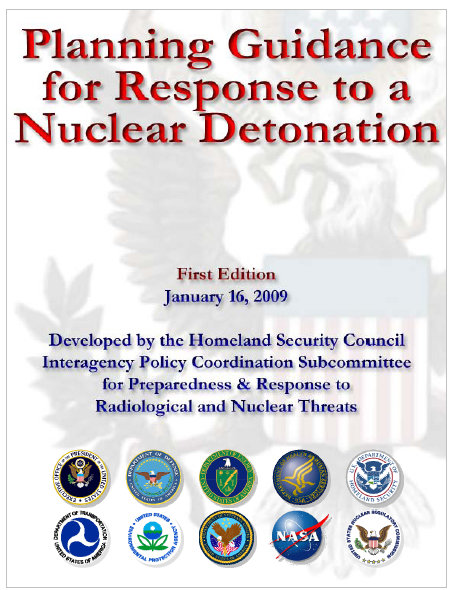 Homeland Security Council
Homeland Security Council
- 97 pages
- January 16, 2009
One of the most catastrophic incidents that could befall the United States (US), causing enormous loss of life and property and severely damaging economic viability, is a nuclear detonation in a US city. It is incumbent upon all levels of government, as well as public and private parties within the US, to prepare for this incident through focused nuclear attack response planning. Nuclear explosions present substantial and immediate radiological threats to life. Local and State community preparedness to respond to a nuclear detonation could result in life-saving on the order of tens of thousands of lives.
The purpose of this guidance is to provide emergency planners with nuclear detonation specific response recommendations to maximize the preservation of life in the event of an urban nuclear detonation. This guidance addresses the unique effects and impacts of a nuclear detonation such as scale of destruction, shelter and evacuation strategies, unparalleled medical demands, management of nuclear casualties, and radiation dose management concepts. The guidance is aimed at response activities in an environment with a severely compromised infrastructure for the first few days (e.g., 24 – 72 hours) when it is likely that many Federal resources will still be en route to the incident.
…
Light Damage (LD) Zone:
- The outer boundary of the LD zone may be defined by the prevalence of broken windows, with approximately 25% broken. This corresponds to approximately 0.5 psi. Shattering of windows and associated injury from flying glass will occur to about three miles (4.8 km) from ground zero making this distance a reasonable estimate of the outer boundary of the LD zone. However, window breakage may occur to a lesser degree out to five miles (8 km) or more from ground zero.
- Doors and window frames may be blown in at overpressures of about two psi. Essentially all windows will be shattered out to one psi and perhaps 25% at 0.5 psi.
- As a responder moves inward, windows and doors will be blown in and gutters, window shutters, roofs, and light construction will have increasing damage. Litter and rubble will increase moving towards ground zero and there will be increasing numbers of stalled and crashed automobiles, making emergency vehicle passage difficult.
- Blast overpressures that characterize the LD zone are calculated to be about 0.5 psi at the outer boundary and 2–3 psi at the inner boundary. More significant structural damage to buildings will indicate entry into the moderate damage zone.
Moderate Damage (MD) Zone:
- Responders may expect they are transitioning into the MD zone when building damage becomes substantial. This damage may correspond to a distance of about one mile (1.6 km) from ground zero for a 10 KT nuclear explosion.
- Observations in the MD zone include significant structural damage, blown out building interiors, blown down utility poles, overturned automobiles, some collapsed buildings, and fires. In the MD zone sturdier buildings (e.g., reinforced concrete) will remain standing, lighter commercial and multi-unit residential buildings may be fallen or structurally unstable, and most single-family houses would be destroyed.
- Substantial rubble and crashed and overturned vehicles in streets are expected, making evacuation and passage of rescue vehicles difficult or impossible without street clearing. Moving towards ground zero in the MD zone, rubble will completely block streets and require heavy equipment to clear.
- Within the MD zone, broken water and utility lines are expected and fires will be encountered.
- Many casualties in the MD zone will survive and these survivors, in comparison to survivors in other zones, will benefit most from urgent medical care.
- A number of hazards should be expected in the MD zone, including elevated radiation levels, potentially live, downed power lines, ruptured gas lines, sharp metal objects and broken glass, ruptured vehicle fuel tanks, and other hazards.
- Visibility in much of the MD zone may be limited for an hour or more after the explosion because of dust raised by the shock wave and from collapsed buildings. Smoke from fires will also obscure visibility.
- Blast overpressures that characterize the MD zone are: outer boundary, about 2–3 psi, and inner boundary, about 5–8 psi. When most buildings are severely damaged or collapsed, responders have encountered the no-go zone.
No-go (NG) Zone:
- Few, if any, buildings are expected to be structurally sound or even standing in the NG zone, and very few people would survive; however, some people protected within stable structures (e.g., subterranean parking garages or subway tunnels) at the time of the explosion may survive the initial blast.
- Very high radiation levels and other hazards are expected in the NG zone making this zone gravely dangerous to survivors and responders; therefore, the NG zone should be considered a no-go zone during the early days following the explosion.
- Rubble in streets is estimated to be impassable in the NG zone making timely response impossible. Approaching ground zero, all buildings will be rubble and rubble may be 30 feet deep or more.
- The NG zone may have a radius on the order of 0.6 miles (1.0 km). Blast overpressure that characterizes the NG zone is 5–8 psi and greater.

